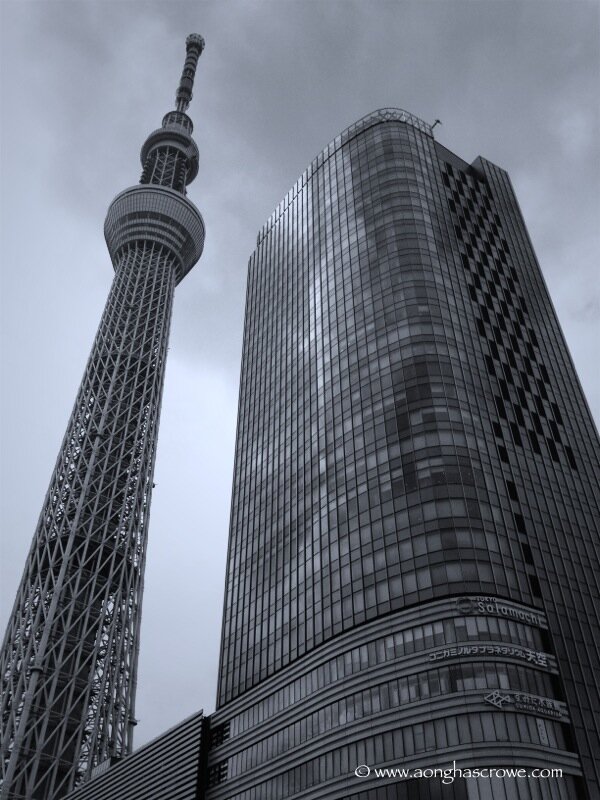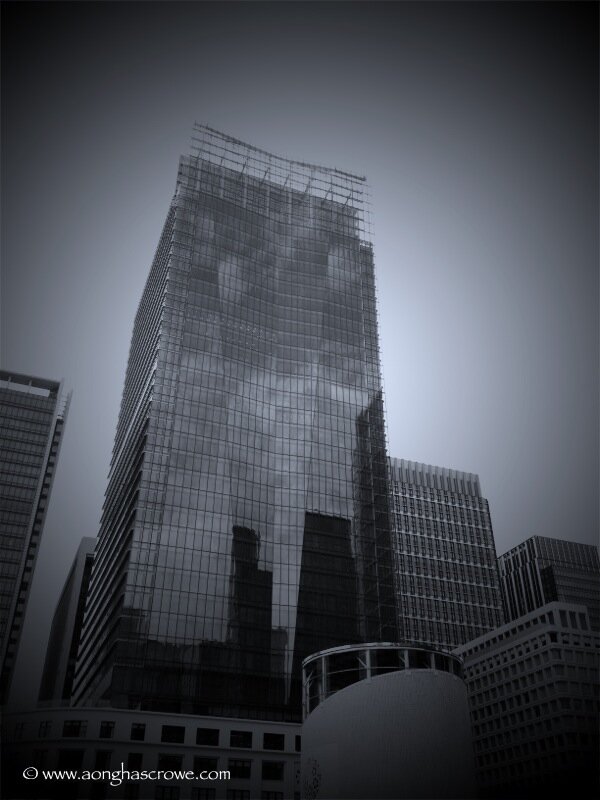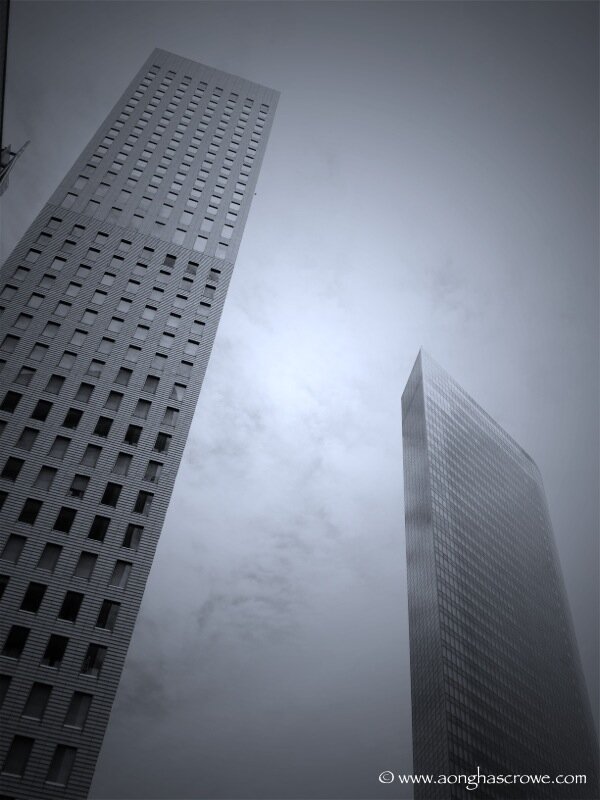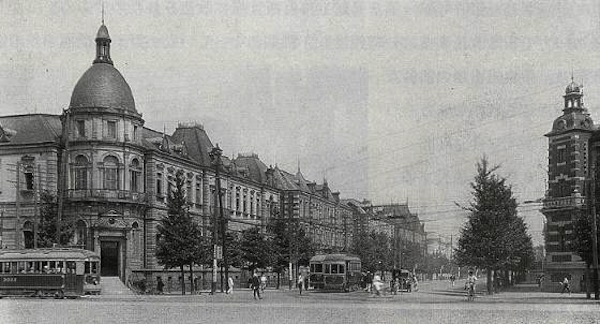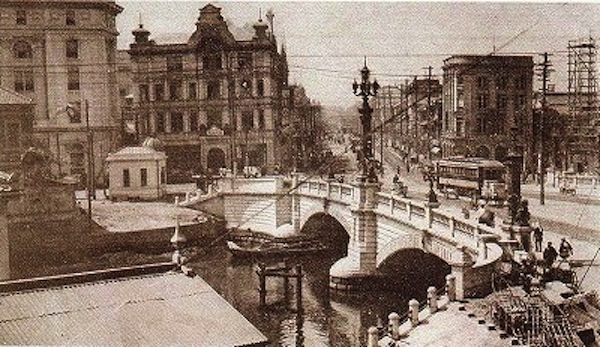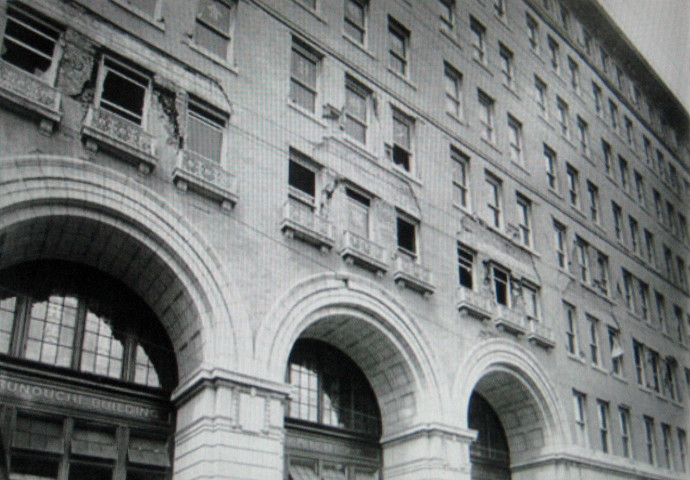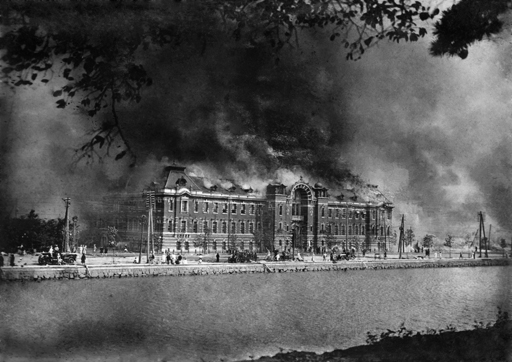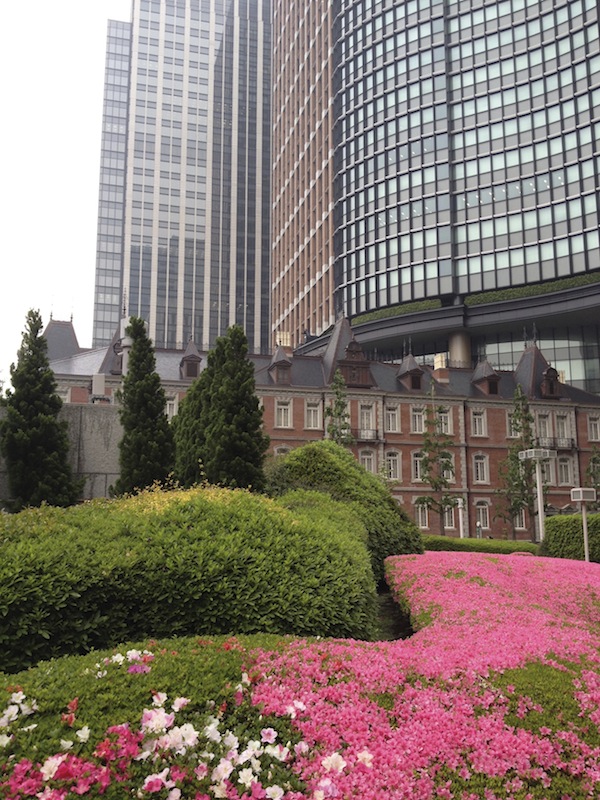Tatsuno Kingo’s Works
This painting of 45 of Tatsuno Kingō’s works, including The Bank of Japan (center) and Tōkyō Station (background) gives an idea what the Marunouchi area used to look like before the Great Kantō Earthquake of 1923, WWII, and the Great Wrecking Ball of the 1950s, 60s, and 70s. For more on Marunouchi, go here.
According to Wiki, “Following the Meiji Restoration, Marunouchi came under control of the national government, which erected barracks and parade grounds for the army.
“Those moved in 1890, and Iwasaki Yanosuke, brother of the founder (and later the second leader) of Mitsubishi, purchased the land for 1.5 million yen. As the company developed the land, it came to be known as Mitsubishi-ga-hara (the "Mitsubishi Fields").
“Much of the land remains under the control of Mitsubishi Estate, and the headquarters of many companies in the Mitsubishi Group are in Marunouchi.
“The government of Tokyo constructed its headquarters on the site of the former Kōchi han in 1894. They moved it to the present Tokyo Metropolitan Government Building in Shinjuku in 1991, and the new Tokyo International Forum and Toyota Tsuho Corporation now stands on the site. Nearly a quarter of Japan's GDP is generated in this area.
“Tokyo Station opened in 1914, and the Marunouchi Building in 1923. Tokyo Station is reopened on 1 October 2012 after a 5 year refurbishment.”
Iccho Rondon
One of my favorite areas of Tōkyō is Marunouchi, the commercial district located between Tōkyō Station and the Imperial Palace. I love the architecture, both old and new, the wide, uncluttered tree-lined streets, the proximity to the Imperial Palace, and, well, I could go on and on.
The land where Marunouchi stands today was originally an inlet of Edo (Tōkyō) Bay. It was reclaimed in the late 1600s and during the Edo Period (1603-1868) feudal lords close to the Tokugawa Shogunate, known as fudai daimyō, maintained homes in the area. Following the Meiji Restoration, the land was used as a barracks and parade ground for the Imperial Army. And around 1890, the land was bought by the Mitsubishi company which began to develop it as a center for business. Mitsubishi still owns much of that prime real estate today.
The first "Mitsubishi Ichi-gō Kan" (Building No.1) was completed in 1894 (Meiji 27). It was followed by the construction of a large number of similar brick buildings, and by the early 1900s the area was nicknamed Icchō Rondon (一丁 ロンドン One-Mile London) because of its resemblance to the British capital.
Tōkyō Station, designed by Kingo Tatsuno, was completed in 1914.
As is sadly all too common in Japan, very little of Icchō Rondon remains today. Except for Kingo Tatsuno's Tōkyō Station, and the Ministry of Justice building near Hibiya Park, I don't think any buildings from the era have survived. If you ask your Japanese friends why, they'll probably shrug. Push them a little and they might venture a guess that the area had been destroyed in the Great Kantō Earthquake of 1923.
There is some truth in that. The massive quake, which killed an estimated 140,000 people in the fires alone, destroyed much of the city, including parts of Marunouchi.
Damage to the Marunouchi Building. The original building was completed in 1923. Today's building was completed in 2002.
Metropolitan Police Department burning at Marunouchi. Going, going, . . .
The earthquake, however, explains only part of the story: many of Marunouchi's brick and stone buildings, though damaged, continued to be used long after the Great Kantō earthquake.
The aerial bombings of Tōkyō during the Pacific War also took their toll. B-29 raids from the Marianas began on 17 November 1944 and continued right up until the day Japan capitulated on 15 August 1945. The Operation Meetinghouse air raid of 9–10 March 1945 is estimated to be the single most destructive bombing raid in history, wiping out more than 50% of the city.
For more on the war and the bombing of Japan, watch the documentary "Victory in the Pacific by WGBH's American Experience.
I have no idea when these photos were taken. Many of the modern-looking buildings were built in the 30s. The Dai-ichi Seimeikan which housed the GHQ of the occupational forces was built in 1938. The Tōkyō Chūō Post Office (the white building just left of Tōkyō Station) was built in 1933. The outer portion of the post office remains today and was incorporated into the design of the new Kitte Building that was finished in 2012.
This photo was probably taken in the sixties, judging by the extent of development. It amazes me that the Japanese will build something, tear it down, build something else, tear that down, then build yet another building. There doesn't seem to be a sense of permanence in the designs, something that is not new to Japan. The Dai-ichi Seimeikan replaced a beautiful brick building. (You can see it in the second photo from the top. It is the building on the left side of the street with the street car in front of it.) The exhibit at Seimeikan says that it was a bold move by the architects to do away with the original building. Bold? I'd say it was egotistical and rash. They took a a real gem of a building and replaced it with something you see in pretty much any city today. But, hey, that’s progress!
Marunouchi today
Mitsubishi's Ichigōkan today. Completed in 2009, it is an exact replica of the original Ichigōkan which had stood on that corner from 1894 until 1968. Wouldn't it have been better, and certainly cheaper, to just keep the original Ichigōkan? Apparently there was a movement to try to protect the building, but they failed to keep it from being torn down. Sigh.
Frank Lloyd Wright's Imperial Hotel, Tōkyō suffered a similar fate. Although it managed to come through both the Great Kantō earthquake and World War II unscathed, it was no match for the wrecking ball. Fortunately, the central lobby and reflecting pool were disassembled and rebuilt at The Museum Meiji Mura in Nagoya.
Ala Moana Beach Park, Honolulu
The Grass is greener . . .
Playing soccer with my sons in the local park, I tripped as I was dribbling the ball and face-planted into the ground. It wouldn’t have been half as painful if the goddamn pitch we were playing on wasn’t gravel.
Japanese friends and family, the above is what a park looks like in the U.S. Please note how the grass is cut regularly, perhaps as many as two times a week, and watered, yes watered, regularly so that it stays green even in the dry season. Lush, green grass, imagine that!
Diamond Head State Park, Honolulu
Inside the Diamond Head State Monument. Again, the grass is cut and watered. Looks nice doesn't it? Kind of makes you want to roll about on it, or spin aound like my wife is doing in the photo, or just lie down it and look up at the sky.
But this is Hawaii, you might say. The climate there is just perfect for parks.
Okay. The next picture is from San Francisco:
Maritime Garden, San Francisco
Cute kid, if I don't mind saying so myself.
Admittedly not the best photo, but it proves that even in the middle of winter, San Francisco, which tends to be rather chilly and overcast most of the time, also has nice green grass in its public parks. This picture was taken near Ghiradelli Square where you'll find quite a lot of tourists and homeless people (many of whom have apparently gone off their Perphenazine--the homeless, mind you, not the tourists).
Also note the trashcan. Not only is the design pleasing to the eye, it is not overflowing with garbage. Why's that, you ask. Because they are emptied regularly. Novel idea, isn't it? See you don't have to wait until they are filled to overcapcity like commuter trains in Tōkyō.
The following photo is from Portland, Oregon:
Park Blocks, Portland
Again, this photo was taken in the dead of winter when the sun rarely shines, and yet the grass is still nice and green. A bit bald in spots, but that can'be helped. All the rain tends to make the ground soggy and prone to damage by pedestrians. Leaves are picked up at regular intervals, too. See, you don't have to drastically cut the limbs of the trees in autumn. Let the leaves fall as Mother Nature intended and then rake them up later. Revolutionary!
And this is what one of the better parks in Fukuoka looks like:
Maizuru Park, Fukuoka
Yikes!
I hiked all the way to the park with the intention of playing catch with my son, but . . . For crying out loud, when was the grass last cut?
I wasn't so much worried about losing the ball among the weed as I was about losing my sons.
You know, when you don't maintain the parks, it's no wonder so few people visit them. Then again, that may be the idea behind the lack of maintenance. The fewer the visitors, the less work the parks administration has to do cleaning up after all those people. There's less litter to pick up, fewer garbage cans that need emptying . . . Hmm. Maybe they know what they're doing after all.
To be fair, . . .
Shinjuku Gyōen, Tōkyō
. . . there are some nice parks in Japan. These photos were taken at Tōkyō's Shinjuku Gyoen, which is located betwen Yoyogi and Shinjuku stations.
It's a great park. Unfortunately, admission is not free.
What I'm getting at is this: if fat, lazy, and stupid Americans can maintain parks, then surely the Japanese can do it, to. Give it a try!

